 |
Written by Jane Waldron Grutz
Photographs and drawings courtesy of Craver Farms and The Arabian Horse Trust |
 n July 5, 1906, American political cartoonist Homer Davenport set out on a journey that would ultimately take him to Aleppo and the nearby reaches of the Syrian desert.
n July 5, 1906, American political cartoonist Homer Davenport set out on a journey that would ultimately take him to Aleppo and the nearby reaches of the Syrian desert.
With him he carried letters from President Theodore Roosevelt and the Turkish ambassador in Washington, D.C.—letters meant to pave the way for him to acquire fine Arabian horses for a proposed us cavalry breeding program. In fact, they would achieve far more than that. As Davenport would soon discover, these letters would alter his life and allow him to bring some of the most storied horses of the desert back to his Davenport Desert Arabian Stud in Morris Plains, New Jersey.
Davenport, then 39, was a native of Silverton, Oregon, where his father, Timothy, had encouraged both his artistic career and his love of horses. As Homer Davenport relates in his book, My Quest of the Arabian Horse, his father’s tales of dashing desert horsemen and their gallant steeds filled his boyhood dreams—not to mention his sketch pad, which he covered with prancing Arabian mounts.
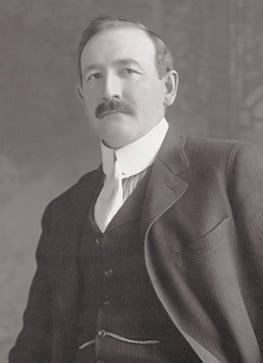 |
 |
| Homer Davenport, left, and Ahmet Hafiz, right, met in Aleppo, Syria, in 1906, when Davenport arrived seeking foundation stock for a us-cavalry breeding program. Their shared deep love for fine Arabian horses made them fast friends. |
It would be many years, however, before Davenport ever actually saw so exotic an animal.
 |
| Homer Davenport’s 1904 cartoon showing Uncle Sam endorsing Theodore Roosevelt helped win the president his second term. Not long after that, Davenport requested and received Roosevelt’s support for importing Arabian horses to the United States. |
Real Arabian horses were few and far between in the us at that time. In fact, the first Arabians to arrive in any numbers—and to be on view to the public—were the Hamidie Society horses (pronounced ham-ee-dee-yeh), almost certainly named after the Ottoman Sultan Abdul Hamid ii. These highly bred animals were imported by a Syrian consortium to perform at the 1893 World’s Columbian Exposition, also known as the Chicago World’s Fair.
Davenport wrote that he chanced upon the horses with “big sparkling eyes and gracefully carried tails” as they paraded down Chicago’s State Street. He was so entranced with them that he was soon spending his days watching them perform on the fair’s midway instead of completing his assignments as an artist for the Chicago Herald.
This dereliction of duty ultimately cost Davenport his job, but he was only 26 and obviously talented, and soon landed a position with William Randolph Hearst’s San Francisco Examiner. In 1895 he moved to Hearst’s New York Journal, where his enormously popular antitrust cartoons quickly won him the friendship of President Teddy Roosevelt, as well as a very comfortable salary.
Davenport never lost his love of Arabians, however, and in 1898 he acquired one of the beautiful Hamidie horses he had so admired.
The Hamidie Society had fared badly as a result of the World’s Fair. The consortium had spent far more to purchase, transport and stable the best Arabian horses it could find than it collected in revenue, and was forced to sell 28 Arabians at public auction soon after the fair closed.
Several of these horses went to Peter Bradley, a wealthy industrialist and proprietor of the Hingham Stock Farm in eastern Massachusetts. Davenport—who had been searching for the horses ever since the World’s Fair closed—visited Bradley and purchased the Hamidie stallion Koubishan. The two enthusiasts hit it off and later formed a partnership to import Arabian horses, with Bradley largely funding
Davenport’s 1906 trip to Arabia.
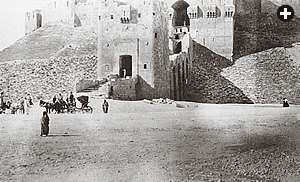 |
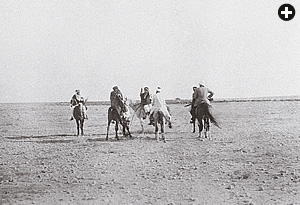 |
| Davenport, his two assistants and his interpreter arrived in Aleppo, famous for its stone citadel, top, on August 6, 1906. From Aleppo, Davenport located members of the Anazeh, whose messengers, above, met Davenport and his companions in the desert and guided the visitors to the Anazeh camp. |
Help of another kind came from President Roosevelt. Hoping the Arabians would provide foundation stock for a proposed cavalry breeding program, he asked Secretary of State Robert Bacon to formally request permission for the imports. For several decades the Ottoman Empire, which included today’s Syria and the Levant, had ruled strictly against the export of asil (purebred) mares. But Davenport was fortunate: The official letter from the secretary of state, coupled with considerable help from fellow horse enthusiast Chikeb Bey, the Turkish ambassador, had the desired effect. Within weeks of applying, Davenport received an imperial irade, or permit, allowing him to export “six or eight Arabian mares” to the us.
With the irade in hand, Davenport set out on a French Line vessel to begin his journey to the great Syrian desert lands of the Anazeh, by far the most powerful confederation of tribes and sub-tribes west of the Euphrates River. The Anazeh were also known to have the best Arabian horses.
Wilfred and Lady Anne Blunt, famous for their Crabbet Stud in England, had acquired most of their fine Arabians from the Anazeh on their travels in the region in 1878 and 1881. As Davenport knew well, several of these animals had been purchased in El Deyr, or Dayr al-Zor, a horse-trading center some 400 kilometers (250 mi) southwest of Aleppo.
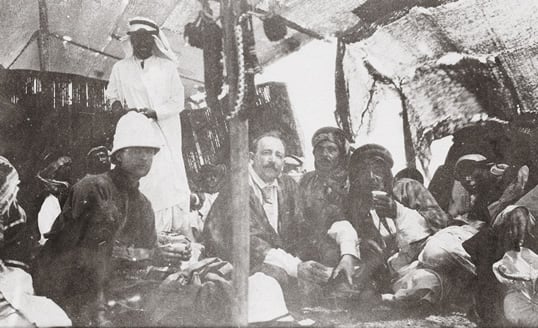 |
| In the camp of the Fedaan tribe of the Anazeh, Davenport (center) felt so at ease that he was moved to declare that he had known from childhood that he was destined to become a member of the tribe. Hanging from the tent pole is the halter of a war mare, which is a symbol of welcome. |
It was to Dayr al-Zor that Davenport was headed. Accompanying him were John H. Thompson, Jr., whom Davenport described as an “athletic young man with the snappiest eyes in New York,” and Arthur Moore, a younger man whose most visible qualification for the trip was his towering 193-centimeter (6' 4") frame.
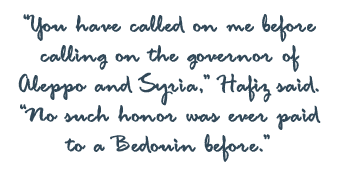 Their sea journey to Le Havre went well and, after a comfortable train ride across Europe, the men arrived in Constantinople on July 19. With help from the us Embassy, they were able to have the irade amended to include stallions as well as mares. The embassy also warned them of the malarial mosquitoes then infecting Alexandretta (modern Iskenderun) on the northeastern Mediterranean coast and the intolerable heat they would find in Aleppo. Dayr al-Zor would be even worse.
Their sea journey to Le Havre went well and, after a comfortable train ride across Europe, the men arrived in Constantinople on July 19. With help from the us Embassy, they were able to have the irade amended to include stallions as well as mares. The embassy also warned them of the malarial mosquitoes then infecting Alexandretta (modern Iskenderun) on the northeastern Mediterranean coast and the intolerable heat they would find in Aleppo. Dayr al-Zor would be even worse.
Worried but determined, the men set out on an 11-day sea journey to Alexandretta, stopping first in Beirut, where they acquired the services of Amin Zaytoun, a skilled interpreter who would prove his worth many times over as they traveled deep into the tribal lands of
the Anazeh.
But Zaytoun could not control the problems that greeted them at Alexandretta. The dreaded mosquitoes were certainly there, but so was a malevolent customs agent who confiscated their rifles. When they learned the weapons would not be returned until a cable arrived from authorities in Constantinople, Davenport and Moore set out for Aleppo, leaving Thompson and Zaytoun
to wait.
After a difficult two-day journey, Davenport and Moore arrived in Aleppo only hours before Thompson and Zaytoun. All were the worse for wear. Furthermore, they had no idea where to find the Anazeh or Arabian horses they had come to acquire. Undeterred, they set out for the one place they knew would be associated with horses: the suq, or market, where Arab bridles and saddles were made and sold.
 |
| Throughout his journey, Davenport’s pen and sketchbook were rarely far from his hand. Here he depicts “Akmet Haffez my brother and his filly Jedah.” At the end of Davenport’s visit, Hafiz told him that if he didn’t return to Syria, Hafiz would visit America. Sadly, Davenport died just six years later, and the two never met again. |
There their luck began to change. In the suq, Davenport spotted two men with exceptionally white teeth. Remembering that Lady Anne Blunt had mentioned the white teeth of the Anazeh in one of her books, Davenport introduced himself with Zaytoun’s help. Yes, he was told, the men were members of the Anazeh tribe and indeed, Hashem Bey, the supreme shaykh of the Anazeh, was in town visiting Ahmet Hafiz, the representative of the Bedouin tribes to the Ottoman government. Even better, one of the men offered to take them to Hafiz’s house then and there.
Davenport was interested in horses, not protocol, so it never occurred to him that, as someone carrying official papers from two important heads of state, he should first have called on the Ottoman governor of Aleppo. It was the hope of meeting Hashem Bey and buying horses straight from the Anazeh, without having to journey all the way to Dayr al-Zor, that brought him and Thompson to the majlis, or audience room, of Ahmet Hafiz.
Hashem Bey had already left, but Davenport could hardly have been more impressed with the “noble elderly-looking Arab” who entered the majlis to greet him and Thompson. “Anywhere he would have attracted instant attention,” wrote Davenport of Hafiz, whose word, as the intermediary between the Ottoman Empire and the Bedouin tribes, “was absolute law, from the great Anazeh down to the smaller tribes.”
Given their shared interest in horses, Hafiz probably would have helped Davenport in any case, but when Zaytoun informed him that Davenport carried an irade from the sultan and papers from the us president, Hafiz could hardly believe his ears.
“Then you have called on me before calling on the governor of Aleppo and Syria,” Hafiz said, overwhelmed. “No such honor was ever paid to a Bedouin before,” he continued. “If I live to be one hundred years old, my smallest slave would honor me more for this visit.
“But you have not come here to see men,” he added, repressing his emotion. “Better than that, you have come to see horses, and I would be selfish if I kept you longer from seeing the greatest mare of our country—the war mare of the great Hashem Bey.”
Two Arabian mares in colorful Bedouin regalia awaited them in the courtyard. The taller one was Wadduda, a chestnut that had been the favorite war mare of Hashem Bey for four years. Beside her stood Abeyah, a small bay mare which, in the words of Hashem Bey, had “the most extraordinary head in the desert.”
Hafiz’s sons showed off the horses. Wadduda came first, reported Davenport, “tearing down toward us all afire, … the bounding tassels around her knees, looking like silk skirts. Such action over such rolling rocks. Her tail was high and her eyes fairly sparkled.”
Then Abeyah galloped down the rock-strewn lane “with even more fire than the other.”
Just to see such horses would have been enough for one day. But Hafiz had a bigger surprise in store. Though he was well into his 60’s and had not visited the desert for almost 30 years, he insisted on accompanying Davenport on his quest to meet Hashem Bey and see the fabled horses of the Anazeh. But that would only happen, Zaytoun told Davenport, if he would first accept Wadduda as Hafiz’s present, along with the Bedouin boy who was holding her as her groom. Her name—which means “love” or “affection”—is to remain the same, said the interpreter, adding, “He hopes that when you speak the name it will bear living witness of his love to you and that the gift and its acceptance will be the forming of a friendship and later of a brotherhood that will never end.”
Shocked that his diplomatic blunder had elicited so grand a gesture, Davenport had no idea how to respond. Zaytoun, ever reassuring, explained that, while under ordinary circumstances Davenport could not accept so valuable an animal, in this situation Hafiz would be gravely insulted if he refused his special gift.
After Davenport nodded his acceptance, Hafiz insisted they pay a brief visit to Nazim Pasha, the governor of Aleppo. The group would set out for the desert the following afternoon, but first the visitors must see Haleb, the governor’s legendary brown stallion, called “Pride of the Desert.”
The Americans had been told of this magnificent animal while they were still in Constantinople. Haleb had been given to the governor by the combined tribes of the Anazeh and, though others had tried to buy him, “Pride of the Desert” was clearly beyond any price.
“What a stocky fellow he was! He was powerful enough for any purpose, especially for a long killing race where weight was to be carried,” wrote Davenport, recounting how Hafiz “began on his fingers to count the stallion’s pedigree through his dams’ side, each one of which had been the greatest mare of her time….”
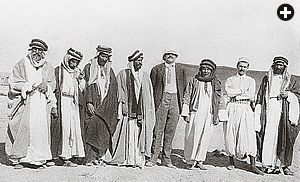 |
| With the “great shaikhs of the Fedaan Anazeh,” Davenport posed for this photo in which he appears at center; to his left stands Ahmet Hafiz, and to his right stands Hashem Bey, the shaykh of all the Anazeh tribes. “We had enjoyed our stay; we had feasted on a camel; we had talked horse pedigrees for days without interruption; we had seen the greatest animals they had,” Davenport wrote. |
As the group left the palace, the governor turned to Davenport and, with great dignity, insisted that the American accept his special gift—nothing less than Haleb himself. There was nothing for Davenport to do but nod in appreciation, though this time he sent the governor’s son a gift of 100 French pounds, a large sum at the time.
Late that afternoon the group set out for the desert territory of the Anazeh. Hafiz rode a spirited bay mare, his son Ali was mounted on Haleb and Davenport rode Wadduda.
At first Wadduda fretted under her new owner, but when they reached the open desert, she sniffed the cooling air and “with a delightful spring” began to gallop across the barren plain. “It was the return home,” wrote Davenport, “the call of the wild life with its thrills of wars and races; with its beautiful open air, as compared with the musty stuffy corral she had been picketed in. She was getting away from civilization and back into the open.”
They galloped on for some distance, Davenport “wrought up to a state of much excitement” as he remembered the stories of Arab horses his father had told him as a child and the drawings he had made of them. “It was hard to realize that I was I and that I was astride the most distinguished mare of the desert. I seemed to realize what she was and what she meant to me. My face was dripping again (with tears of joy), and I felt glad I was alone.”
But they were not to remain alone for long. The others soon caught up with them and together they journeyed on, reaching the camp of the Fedaan tribe of the Anazeh late the following morning.
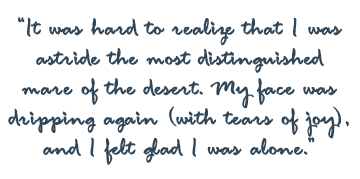 The party was greeted with great acclaim and ushered into a tent, where Wadduda’s bridle was tied to the tent pole as a sign of welcome. It was now up to Davenport to speak. Too exhausted even to stand, he asked Zaytoun to tell the Anazeh that, although he had been born in far-off “Americ,” he had known even as a child that he was meant to be a member of their tribe. Then, with great feeling, he turned to Hafiz and thanked him for making possible “the supreme moment of my life.”
The party was greeted with great acclaim and ushered into a tent, where Wadduda’s bridle was tied to the tent pole as a sign of welcome. It was now up to Davenport to speak. Too exhausted even to stand, he asked Zaytoun to tell the Anazeh that, although he had been born in far-off “Americ,” he had known even as a child that he was meant to be a member of their tribe. Then, with great feeling, he turned to Hafiz and thanked him for making possible “the supreme moment of my life.”
Without hesitation, Hafiz replied, “No, the day is ours, not yours; ever since the Anazeh became a tribe we have known that one of us was missing. Now you have come and the number is complete. Today we celebrate the gathering of the entire tribe.”
“And thus,” wrote Davenport, “was I received by the Anazeh.”
After the group had rested, Hafiz addressed the tribesmen, telling them that Davenport had come to study pure Arab horses, and that he would write and tell the world of their greatness. He then asked them to show Davenport any fine breeding horses they had for sale, explaining that he would take them back to “Americ” and, through breeding, preserve the blood of the tribe’s finest asil Arabians.
One by one, the horses were brought forward. With Hafiz’s help, Davenport settled on an exceptional two-year-old colt “absolutely free from blemish of any kind,” as well as a frisky four-year-old. Davenport also admired several mares, but the tribesmen did not wish to part with them, for it was the mares they rode to war and the mares, too, that presented them each year with a fine colt or filly.
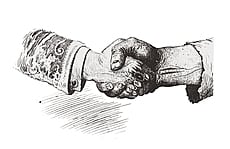 After several days, it was time to visit Shaykh Ali of the Abogonese, a branch of the Anazeh. Aware of Davenport’s quest, Shaykh Ali suggested that the group set out for some Circassian villages near the Euphrates, where a remarkable gray colt was said to be for sale. The horses there proved to be of exceptional quality, and Davenport purchased not only the gray colt, but also a bay colt and a two-year-old just brought in from Dayr al-Zor. The two-year-old was so “full of life,” wrote his new owner, that even in his hobbles “he managed to make much play.”
After several days, it was time to visit Shaykh Ali of the Abogonese, a branch of the Anazeh. Aware of Davenport’s quest, Shaykh Ali suggested that the group set out for some Circassian villages near the Euphrates, where a remarkable gray colt was said to be for sale. The horses there proved to be of exceptional quality, and Davenport purchased not only the gray colt, but also a bay colt and a two-year-old just brought in from Dayr al-Zor. The two-year-old was so “full of life,” wrote his new owner, that even in his hobbles “he managed to make much play.”
As the days went by, Davenport and Hafiz became ever closer and, in a ceremony much honored by the Anazeh, the two became brothers. In the presence of many witnesses, they held up their right hands and pledged before God that they would be “brothers, today and tomorrow and forever brothers.” Afterward, Hafiz asked the American if he felt any different and Davenport replied that he did not. Apparently they had been brothers “all along,” Davenport said. They just hadn’t known it.
When they returned to the camp of the Fedaan, Hashem Bey was waiting for Davenport. Sadly, the two men were disappointed in one another. Davenport felt that Hashem Bey lacked the generous spirit of Hafiz, while the shaykh was sorry that the governor had given the best of the Anazeh horses to Davenport.
Nevertheless, they parted amicably when the Americans began their long journey back to Aleppo. Spending their first night near a spring, the men were awakened by an Anazeh tribesman whose bay mare, Urfah, they had greatly admired a few days before. With him was Urfah’s two-year-old colt, Hamrah, which the tribesman had promised to show Davenport. The colt was as fine as his mother and Hafiz, acting for Davenport, quickly closed the deal.
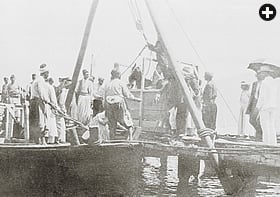 |
| On August 28, 1906, Davenport oversaw the loading of 27 Arabian stallions and mares onto the lighter that carried them to the steamer Singapore, anchored at Alexandretta, for the first leg of the journey to New York. |
The tribesman said he would return the next night with the mare’s year-old foal, Euphrates. Acting once again for Davenport, Hafiz attempted to buy the mare as well as the foal. The two quickly came to terms on the foal and, to the Americans’ surprise, the tribesman said he would consult his family regarding the mare. After much negotiation and some misunderstandings, Urfah finally went to Davenport. But it was clear that the tribesman did not really want to sell a mare that many believed was the finest in the entire Euphrates valley.
Two days later, the group arrived in Aleppo and, this time following protocol, called on the son of the governor, Hikmet Bey. Since the governor had presented Haleb to his American visitor, the Qamasa tribe had replaced him with a two-year-old bay stallion “without flaw,” reported Davenport, who could not but admit his delight when Hikmet Bey—who had not previously honored him with a gift—presented the American with the magnificent stallion.
One further visit remained. The group called on Hassan Tasshin Pasha, the wealthiest man in Aleppo, who was famous for his fine horses. Although he specified that none was for sale, Ahmet Hafiz nonetheless persuaded him to sell Davenport a fine bay stallion as well as a gray mare and her colt.
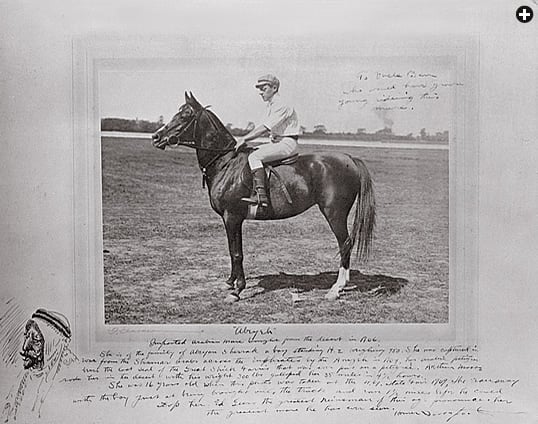 |
| “The most extraordinary head in the desert” was how Hashem Bey, leader of all the Anazeh tribes, described the mare Abeyah, who was the second Arabian horse Davenport saw. In 1909, she posed for this photo at the New York State Fair. |
The journey had come full circle and it was now time to say goodbye to Hafiz. The old man did his best to keep the going-away dinner light and pleasant, but there was an underlying sadness. As the evening drew to a close, Hafiz told the Americans that although their departure “was the great sorrow of his life, he had this one great consolation: We had learned to eat rice with our hands with the Anazeh and we ought to stay and be real Bedouins. By the brightness of our eyes, we had won the tribes and their friendship would always be ours.”
The men finished the meal in near silence and then went to the street below where Davenport and Hafiz embraced in what each must have realized might well be a final farewell.
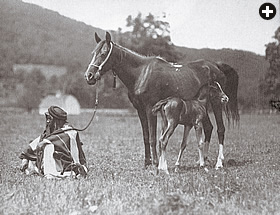 |
| Wadduda—whose name, Hafiz explained to Davenport, means “love” or “affection”—was Hafiz’s original gift to Davenport, along with the services of her groom, Said Abdullah, who returned with Davenport to care for the horses at the Davenport Desert Arabian Stud in Morris Plains, New Jersey, where this photo was made. |
On October 8, 1906, nearly six weeks after leaving Alexandretta, ten spirited war mares and 17 magnificent stallions disembarked at the docks of New York. Davenport and Moore had gone on ahead, but accompanying the horses were Jack Thompson and Said Abdullah, the groom whom Ahmet Hafiz had insisted Davenport bring with him to care for Wadduda.
The highly bred animals attracted nationwide attention and, although Teddy Roosevelt’s hope of using Arabians as foundation stock for the us cavalry would take years to materialize, many of the Davenport horses went on to achieve fame soon after their arrival.
On June 17, 1907, just nine months after the horses set foot in America, Haleb competed against the finest Morgan horses in America and was named the horse best exemplifying the original Justin Morgan, the legendary foundation stallion of the popular American breed.
Another of Davenport’s horses, a “spectacularly beautiful” gray stallion named Muson, created a sensation when ridden by “Buffalo Bill” Cody in the opening days of his 1907 Wild West Show in Madison Square Garden. Letan, sired by Muson, was later ridden by Teddy Roosevelt and appeared in the film A Texas Steer with Will Rogers. And Jadaan, a grandson of Wadduda and Deyr (the two-year-old colt that played in his hobbles), became famous throughout America as Rudolf Valentino’s mount in Son of the Sheikh.
Unfortunately, Davenport did not live to enjoy many of the accolades his horses won. He died just six years after returning from the Syrian desert, leaving his Arabians to his partner, Peter Bradley.
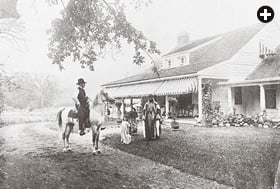 |
| Morris Plains Museum |
| Davenport sits astride Muson, an Arabian stallion, at Red Gables, his home in Morris Plains. Said Abdullah stands next to a child who is believed to be Davenport’s daughter. |
Bradley bred exclusively from the Davenport and Hamidie stock and produced some outstanding Davenport colts over the next several years. In 1918, however, the horses began to be dispersed. Several of them—including Deyr, Jadaan and Letan—eventually went to the W. K. Kellogg ranch, established in 1925 in Pomona, California. Through their appearances in the famous Kellogg Sunday Horse Shows and in movies, the Davenports became popular; their colts were in such demand that today Davenport blood can be found in almost all of America’s 630,000 registered Arabians.
Aside from Davenport and Bradley, however, most owners bred their Davenports with horses from other Arabian lines. As a result, purebred Davenport Arabians were so few by the 1950’s that, had it not been for a few dedicated enthusiasts, the line might well have died out.
One of these enthusiasts was Charles Craver, who in 1955 acquired the Davenport stallion Tripoli, the grandson of Wadduda and Deyr on one side and Urfah on the other. Soon Craver and his wife Jeanne began to acquire other Davenport stallions and mares to begin a program of preservation breeding. Over the next several decades, the Cravers and others like them bred the foundation horses for the more than 600 Davenports that can be found in the us, Europe and the Middle East today.
Like all Arabians, the Davenports are known for their beauty, speed and stamina. Having descended solely from the original Davenport imports, however, these engaging horses differ from their cousins in retaining a certain aura of the desert—a delightful love of life that, could he see them, Ahmet Hafiz would surely recognize.
It was important to Hafiz that Davenport retain the purity of the Arabians he imported. Indeed, when they parted in 1906, Hafiz told Davenport that if he did not return soon, he would visit his American friend to see if he had preserved the bloodline of the horses he had taken away .
Sadly, however, the two men were never able to see one another again. At age 45, Davenport contracted pneumonia and died on May 2, 1912. But he had not failed his friend, for he had laid the groundwork that would ensure that the blood of Hafiz’s desert Arabians would be preserved in the beautiful horses now found throughout the world. Through his writings and his preservation breeding, Davenport made Hafiz’s wish come true.
 |
Jane Waldron Grutz, a former staff writer for Saudi Aramco, is now based in Houston and London, but she spends much of her time working on archeological digs in the Middle East. |